Editor’s Note: This feature originally appeared in the Nov. 2013 issue of No-Till Farmer’s Conservation Tillage Guide.
Not every farmer using precision-ag technology takes time to crunch the numbers and get a tangible feel for their return on investment.
But Ohio no-tiller and strip-tiller Brian Watkins tries to account for nearly every dollar spent on precision tools and how they help improve his family’s 7,000-acre corn and soybean operation near Kenton, Ohio.
Since he began adopting precision practices in the mid-1990s, Watkins estimates a 145% net return — or $216,611 — on their ongoing investment in tools like auto-steer, RTK guidance and variable-rate systems.
“Before we start thinking that precision ag is a magical money tree and we’re just going to go shake it and get this massive return on investment, know that it doesn’t quite work that way,” Watkins says. “The system doesn’t just fall into place.
“It’s a learning process and once you have evolved it, then you can make it pay.”
Pathway To Profits
Trial and error, patience and persistence have all been part of Watkins’ precision journey. For years, a variety of different precision brands for GPS and auto-steer were used to control the farm’s multi-colored fleet of equipment.
|
Ohio strip-tiller Brian Watkins explains the benefits of building his strips in the spring, fine-tuning his fertility program and the payback of precision farming technology in his strip-till operation. |
But like many farmers, they struggled with compatibility. Last winter, they moved to one system for field navigation. They use Ag Leader ParaDyme auto-steer systems in each of their five tractors and subscribe to a cellular RTK data plan to deliver Ohio’s free Continuously Operating Reference Station (CORS) signal for corrections.
“When we’re planting or sidedressing, we can interchange the systems in our tractors if we need to because managing multiple brands was just impossible,” Watkins says.
Before harvest, Watkins moves two auto-steer systems to their Claas Lexion combines, which also have yield monitors.
They have row clutches on their 24-row John Deere corn planter, a variable-rate system on their 24-row Great Plains soybean planter and variable-rate application capabilities on their Hagie sprayer.
Their total investment in technology to date tops $158,000, with the cornerstone of the operation being guidance technology. With auto-steer and swath control, Watkins has improved efficiency, cut fuel and labor costs and been more accurate with fertilizer and seed placement.
“When you are driving across the field and steering an implement by hand, I made the assumption that 75% of the time you are overlapping and 25% of the time you are skipping,” he says. “Part of the benefit of auto-steer and swath control is driving straighter, but it’s also about shutting off the boom on the sprayer when you have point rows or odd-shaped fields.
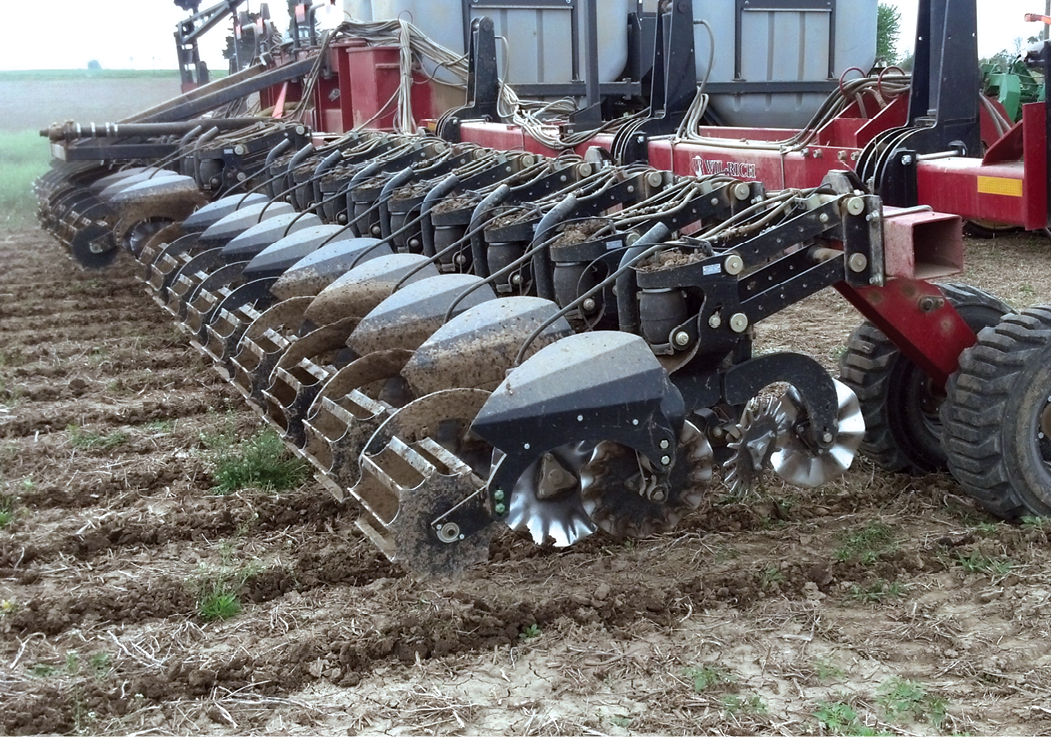 SPRING STRIPS. Brian Watkins builds strips in spring with a 24-row Wil-Rich bar with Dawn Pluribus row units modified with a rolling basket. He prefers a coulter and rolling basket setup to break up clumps and build a good seedbed. Photo Courtesy of Brian Watkins |
“In northwest Ohio, we have a lot of odd-shaped fields. Our average field size is about 75 acres, but we’ve got 80 different fields and I would bet there’s not more than 20 of them that don’t have some sort of a waterway.”
To get the most out of their irregular fields, Watkins researched the benefits of auto-steer and swath control and accounted for variables, including overlaps and skips. While some of his conclusions were based off estimates, Watkins has seen measurable savings from the guidance equipment of more than $156,000.
He’s assumed certain costs — machinery, inputs and labor — but also included some hypothetical goals to assess savings. Watkins set price and yield targets of $12.40 and 58 bushels per acre for soybeans, and $5 and 175 bushels per acre for corn, that translated to about $5,500 in savings through the use of auto-steer and swath control.
He admits the figure pales in comparison to the farm’s $2.2 million machinery budget, but the savings add up once fuel, labor and input figures are included. Based on estimates of $3 per gallon for fuel, labor costs of $24 per hour and 9% depreciation on equipment, they’ve saved $3,000 in fuel and labor with guidance technology.
“One way to look at that is if you get things planted quicker, maybe you get a yield boost out of it. But I’m looking at it a little differently,” Watkins says. “You determine what you need for capacity to get the work done, based on your conditions and what you need. We’re getting about a 10% increase in hours per day we’re able to work because of reduced driver fatigue.”
|
— Brian Watkins |
Using university research, that suggests a 12% yield loss in double-planted corn, a 5% yield loss in double-planted soybeans and a 5% yield loss for over-spraying Watkins says they’ve saved nearly 2% of their input budget through auto-steer and swath control.
They typically spray 3,500 acres of corn twice and 3,500 acres of soybeans three times during the year, so being as accurate as possible with those applications is crucial.
“Those percentages, when looking at an input budget of $1.5 million, add up quickly. We’re looking at saving phosphorus, potassium, nitrogen, seed corn, seed soybeans and spraying,” he says. “With these small improvements, we can save $62,000.”
Variable-Rate Return
For planting, Watkins variable-rates their no-tilled soybeans. For years, they planted in 15-inch rows, but recently switched to 8-inch twin rows.
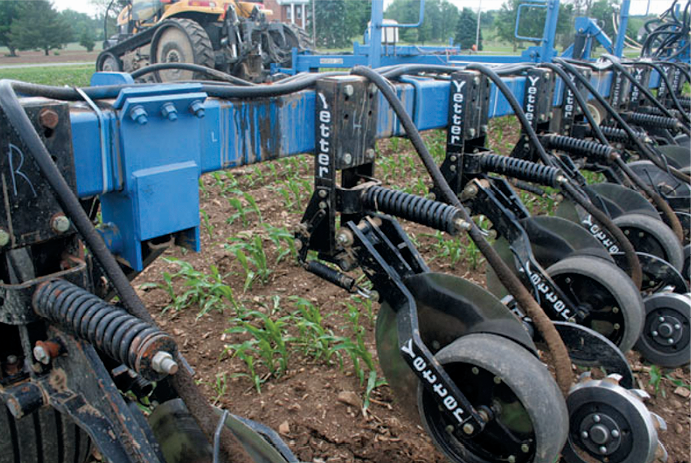 FALL PREPARATION. Watkins runs a 24-row Progressive bar with Yetter Magnum fertilizer coulters to apply potassium and phosphorus in the fall using a Montag dry-fertilizer, air-delivery system. The setup allows him to inject fertilizer about 4 inches deep in the ground so the soil can be left alone until spring. |
The move has allowed Watkins to experiment with their variable-rate program. This year, their average seeding rate was 158,400 seeds per acre — down from 175,000 seeds per acre. The change led to a seed savings of $19,125 and a 2% yield increase on their best soils.
“I believe that if you want to push yields, you have to push populations — even in soybeans,” Watkins says. “But we’re not managing soybeans for super-high populations. We’re not using growth regulators, so if we overplant in good dirt, we’ll get too much foliage. We’ve gotten a $12,586 boost in yield and a total benefit of $31,000 from variable-rate soybeans.”
For corn planting, seed placement is key and Watkins manipulates this manually through the down-pressure monitors on his planter. Although he sees merit in automatic down-force adjustments, Watkins says the manual system is an improvement in their operation.
“We have air bags on the corn planter and springs on the soybean planter, but what we see in our soils is the first time we’re planting, it stays fairly mellow and then we get the rain,” he says. “We come back in and it’s a little damp, so we keep the down pressure low. Then, after that rain and 6 hours of sunshine, it starts to get hard.
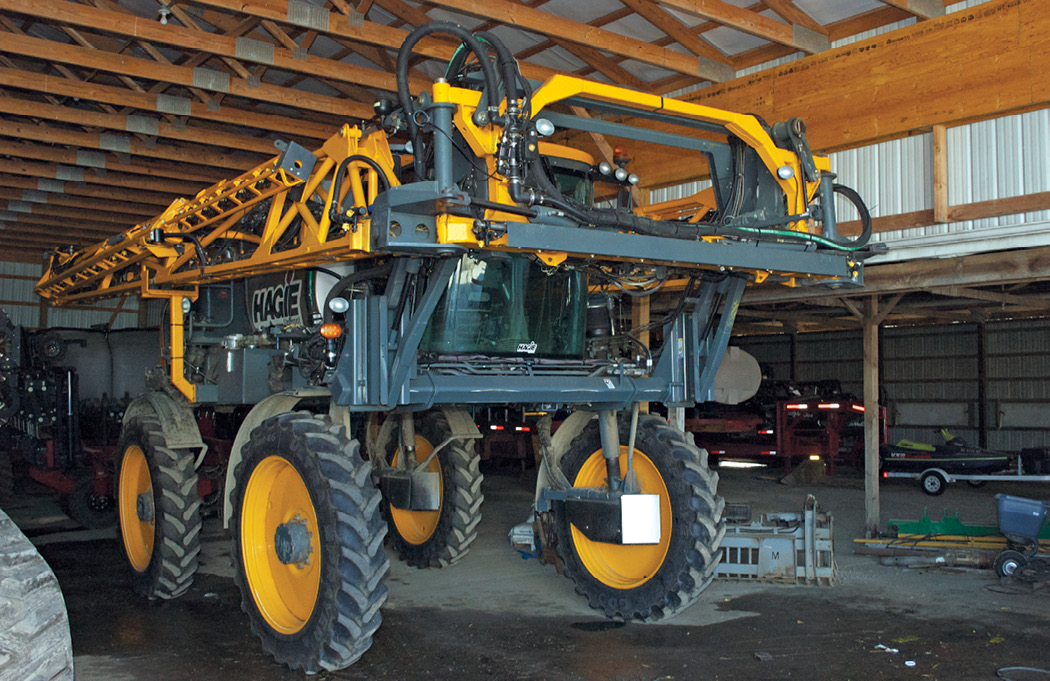 STRAIGHT SHOOTER. With a significant number of odd-shaped fields, Watkins relies on auto-steer and swath control to minimize skips and overlap with his Hagie sprayer. “Part of the benefit is driving straighter, but it’s also about shutting off the boom on the sprayer when you have point rows or odd-shaped fields,” he says. |
“We’ve had this problem before where we’re behind the curve. We’re adding down pressure, but we’re doing it about 6 hours late. And the fact we have a number staring us in the face on that monitor makes a big difference for us to adjust accordingly.”
Hardware is only part of the precision pre- and post-planting puzzle. Watkins invests about $95,000 each year in precision amenities, including data-management consulting and soil testing at $21 per acre. He samples in half-acre grids, and the samples are pulled automatically, analyzed and stored by a consultant. The plan is to do soil samples on 10-year rotations.
“We pay a consultant to warehouse our data and do prescription recommendations,” he says. “It’s not like we’re being spoon-fed this stuff. We work with them to do the number crunching.”
Committing To Strip-Till
When Watkins Farm first incorporated precision technology, they were almost entirely no-till for both corn and soybeans. They attempted strip-till for their corn on and off for about 15 years, but always struggled with getting berms built in the fall.
“With our typically late, wet falls, we couldn’t really do a very good job with tillage, so we kind of gave up the idea of strip-till,” he says. “We tried different things in the spring and thought we had a pretty good no-till system, but it just wasn’t quite what we wanted.”
|
“We’re getting about a 10% increase in hours per day we’re able to work because of reduced driver fatigue…” |
Last year, Watkins came up with a solution. He purchased a 60-foot Progressive toolbar and mounted 24 Yetter 2987 high speed Magnum fertilizer coulters on the bar to apply potassium and phosphorus in the fall using a Montag dry fertilizer air-delivery system.
Watkins says he wanted a flat-fold bar, rather than a vertical bar, to accommodate the dry-fertilizer hoses. The new setup is cleaner and easier to maintain, he says.
The goal with the rig is to inject fertilizer in the fall about 4 inches deep in the ground so the soil can be left alone until spring, when Watkins builds his strips using a Wil-Rich toolbar with 24 Dawn Pluribus row units.
“We’re still fine-tuning, but it’s worked well. This idea of a single-disc, zero soil-disturbance machine is not really tillage,” Watkins says. “It’s strip placement, but there’s really no tillage. It fits our operation better, because as long as it’s not a muddy mess, we can do it. We’re not worried about working up the soil. We’re just placing fertilizer.”
Watkins variable-rates their fall fertilizer application and applies at least the removal rate of phosphorus, as well as 100 to 300 pounds per acre of either diammonium phosphate or monoammonium phosphate.
Soil disturbance is so minimal with the fall rig, he says, that a few weeks after applying the fertilizer, he can’t tell where he drove in the field.
This is where RTK is essential to the success of their strip-till system. He records the A-B lines in the fall and transfers them to the tractor in the spring to make sure the strips are built over those nutrient zones.
With the spring strip-till unit, they apply about 20 gallons per acre of 28% nitrogen at least 2 inches deep with a coulter just to the side of where the corn seed will go.
“We don’t run a knife, just a coulter and a rolling basket, which we added to the row units to break up some clumps and build a better seedbed,” Watkins says. “In the spring, we’re trying to do something fairly light ahead of the planter. A knife would be more disruptive and we might get into some wetter soil down deeper where we don’t want to go.”
Watkins doesn’t apply any fertilizer with the planter, but sidedresses the balance of nitrogen.
Worthwhile Investment
In breaking down their strip-till expenses, Watkins Farm’s move has proven profitable, both with improved yields and reduced input costs. Their strip-till system investment is $268,000, which translates to a direct operating cost of $2.46 per acre.
The biggest savings they see from their strip-till setup is in soluble phosphorus. They’ve been able to save more than $29,000 in phosphorus costs through more precise application at the right time.
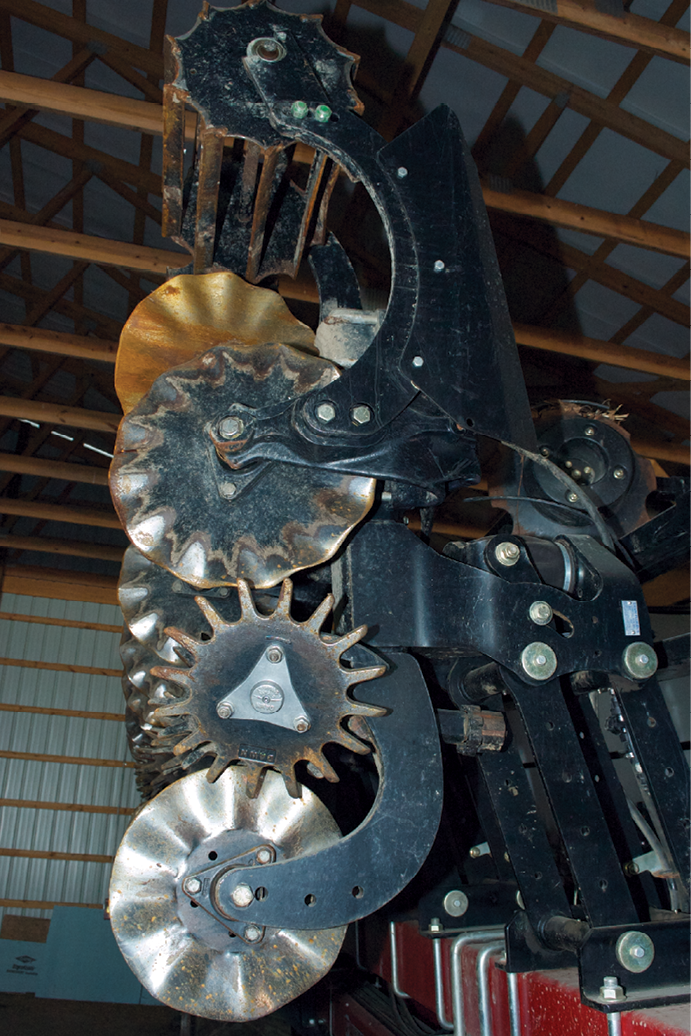 PRECISE PLACEMENT. With the spring strip-till unit, Brian Watkins applies about 20 gallons per acre of 28% nitrogen at least 2 inches deep with a coulter just to the side of where the corn seed will go. |
“We’re guessing at a 5% savings in soluble phosphorus, which is a big deal in Ohio — especially if you’ve done no-till for a long time and you have high phosphorus levels in your surface soil,” Watkins says. “You don’t have enough soil attachment sites for your surface applications and you lose phosphorus.”
Although they’ve had success with no-till corn, the commitment to strip-till 3 years ago has given them a 4% bump in yield, which translates to a $122,000 profit. Overall, the farm has seen a $92,486 return on their strip-till investment, $23,122 of which is attributable to the use of precision guidance.
Watkins admits that when they moved to their current strip-till system, he wasn’t sure how successful it would be. But he’s seen noticeable differences in plant health and says the numbers speak for themselves.
A key benefit has been placement of nutrients below the surface in fall to help protect the phosphorus from flooding rains and make it more available to plants in spring.
“I felt like we would get better, more even distribution of fertilizer and that was worth something,” Watkins says. “With the placement, as far as being able to plant into it, I didn’t know if would work out or not. This year, there was a visual difference, depending on how close we planted to that strip of fertilizer. Plants looked healthier where that seed came into contact with that band sooner and they took off a little faster.”
Looking Ahead
Although they’ve developed a profitable system, Watkins says there is always room for improvement. As an early adopter of precision technology, he’s learned over the years that it takes time, effort and patience to be able to reap the long-term rewards.
|
“We’ve gotten a boost of $12,586 in yield and a total benefit of $31,000 from variable-rate soybeans...” |
“We started with RTK in 2004 and I can promise you that system cost me a heck of a lot more than the one we have now and we didn’t get nearly the benefits we do today,” he says. “I don’t have a single piece of GPS equipment that I purchased in 2004. It’s all gone.”
With technology rapidly evolving, there are always new opportunities to pursue. At least some of those are on Watkins’ radar to potentially increase profitability.
“Wireless communication is a technology that a lot of people are investing in, where you can manage equipment fleets from a central hub,” he says. “To be able to view and send things from one machine to another, and not have to deal with flash drives or other devices, is nice. We’re not there yet, but certainly, we will be at some point.”


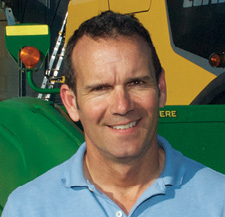

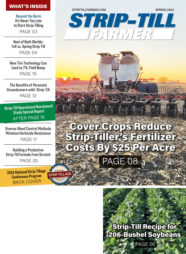
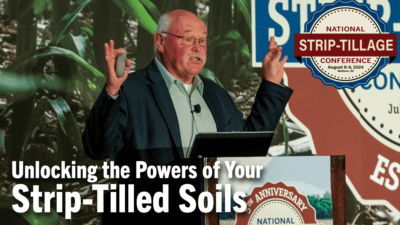



Post a comment
Report Abusive Comment